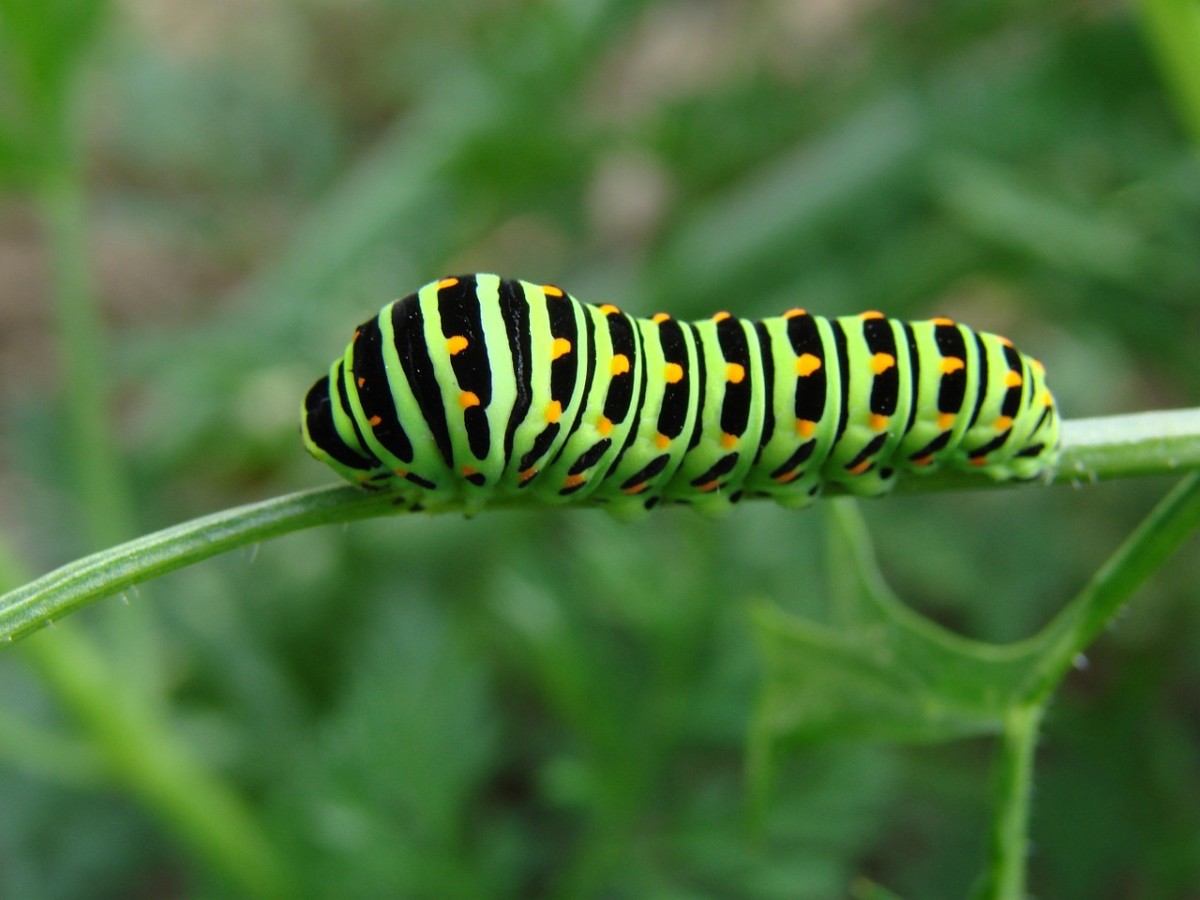Green caterpillars are one of the most noticeable (and often unwanted) garden guests. They like to eat the leaves of many ornamental and edible trees, shrubs, and plants.
Most caterpillars are safe for people to touch, but some may itch if they are, or even spit acid to defend themselves. That’s why you should identify any green caterpillar before you try to pick it up by hand.
Find out what you’re dealing with by reading this A to Z list of the 32 most common green caterpillars in your yard. It tells you how to tell them apart by their size, markings, spines or spikes, the plants they eat, and the butterflies they become.
Please note that if you buy something after reading this article or clicking on one of my links, I may get paid a small fee.
As a gardener or farmer, you may occasionally come across a small green caterpillar with a striking black head munching on your plants These unique-looking creatures stand out from typical green inchworms and loopers But what exactly are they? This guide covers how to identify small green and black caterpillars and provides tips on dealing with them.
Key Identifying Traits
The small green caterpillars with black heads that frequently appear in North American gardens and farms share some key similarities:
-
Size – They are fairly small, averaging 1/2 to 1 inch in length when full grown. Some species may reach 1 1/2 inches.
-
Color – The body is some shade of green – bright green, yellow-green, or olive green. The head capsule is dark black or brown.
-
Movement – When disturbed these caterpillars thrash around rapidly or let themselves drop suspended from a silk thread.
-
Host Plants – They feed on a variety of trees, shrubs, vegetables, and field crops. Preferred hosts depend on the exact species.
-
Habits – Some species roll or tie leaves together to form shelters. Others feed openly.
With these characteristics in mind, here are some of the most common small green and black caterpillars you may encounter:
Obliquebanded Leafroller
The obliquebanded leafroller (Choristoneura rosaceana) is a bright green caterpillar with a black head frequently found in soybean fields, but also feeds on corn, alfalfa, apples, pears, and roses. The larvae reach 1/2 to 3/4 inch long at maturity. As the name suggests, the adult moths have angled, brownish bands across their tan wings.
Pine Sawfly
Several pine sawfly species in the genus Neodiprion have green larvae with black heads. They grow up to 1 inch long and feed in groups on pine needles. Outbreaks of these sawfly caterpillars can severely defoliate evergreen trees.
Azalea Sawfly
The azalea sawfly (Masoncus pyriformis) is common in the southeastern U.S. The yellow-green larvae with black heads feed on azaleas, rhododendrons, blueberries, and other ericaceous plants. They reach 3/4 to 1 inch in length.
Pear and Cherry Slugs
Pear slugs and cherry slugs are actually the larvae of sawflies in the genera Caliroa and Eriocampoides. The slimy green caterpillars have black heads and eat the leaves of pear, cherry, and other fruit trees. They are typically under 1/2 inch long.
Elm Sawfly
The European elm sawfly (Cimbex americana), introduced to North America, is a 1 inch long green caterpillar with a brownish-black head. As the name suggests, it feeds on elm leaves but has also been found on willow, poplar, and birch trees.
How to Control Them
Most of these small caterpillars do minor damage to landscape plants and crops, skeletonizing leaves. Heavy infestations may necessitate treatment. Control options include:
-
Hand removal – Pluck off groups of larvae from plants when first noticed. Drop in soapy water.
-
Organic sprays – Products with Bt-kurstaki, spinosad, or neem oil can be effective if applied when larvae are small.
-
Chemical pesticides – Insecticides containing permethrin, bifenthrin, carbaryl, or acephate can quickly kill larvae but may also impact beneficial insects.
-
Natural predators – Birds, parasitic wasps, and predatory insects help control populations naturally. Avoid broad-spectrum insecticides.
Identifying small green and black caterpillars allows you to know what plants they feed on, how much damage to expect, and their best treatment options. Act promptly if you spot a heavy infestation on valued plants. With quick action and patience for natural enemies, populations should remain in check.
Cabbage white caterpillar (imported cabbageworm)
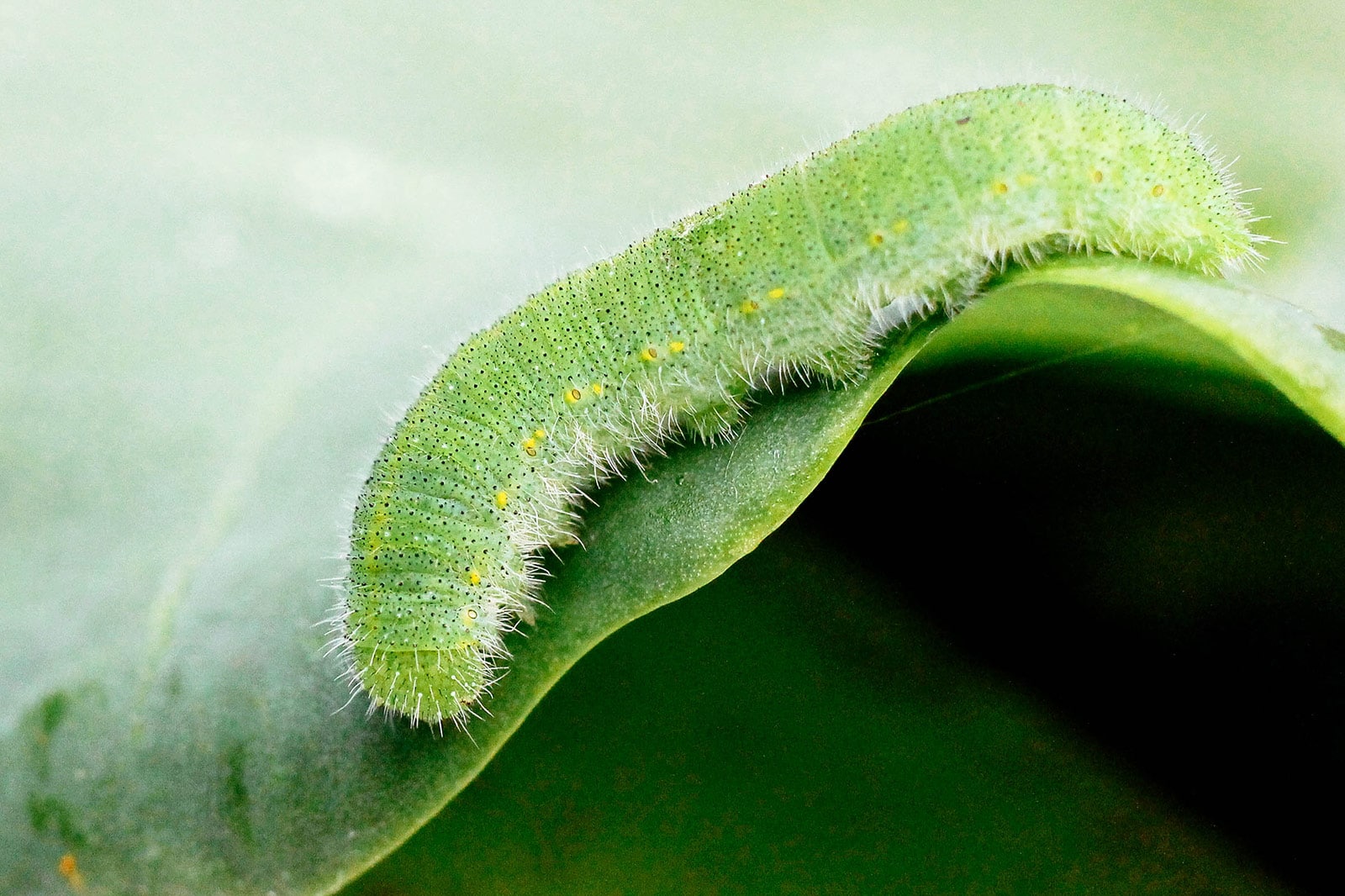
- Scientific name: Pieris rapae
- Turns into: Cabbage white butterfly
- Found in: North America, Europe, Asia, and north Africa
One type of caterpillar that you’ll see a lot is the cabbage white caterpillar, which is also called the imported cabbageworm. This caterpillar is smooth, thin, and light green. It likes to eat broccoli, cabbage, kale, and bok choy, among other vegetables. It can be found in gardens.
It can be very hard for gardeners who like to grow brassicas because cabbage white larvae eat a lot. Just a handful of these caterpillars can decimate an entire crop in a matter of days!.
People sometimes mistake cabbage white caterpillars for cabbage loopers, which also eat brassicas, but cabbage white caterpillars don’t double up as they crawl.
Most cabbage white caterpillars are light green, but some may also be yellow or have yellow spots on their bodies.

- Scientific name: Hyalophora cecropia
- Turns into: Cecropia moth
- Nova Scotia in eastern Canada, Maine, south to Florida, and west to the Canadian and US Rocky Mountains are places where you can find them.
This caterpillar, the cecropia moth, is one of the easiest to spot because of its huge size and striking appearance. It begins life as a yellow or light green caterpillar, gradually maturing into a blue-green color.
All over its body, this caterpillar is ridged and has blue, orange, and yellow bumps that stick out. It also has small black spikes that protect it from being eaten. The blue protuberances are often found running the length of each side.
Cecropia moth larvae are exceptionally large and can grow to be around 10 centimeters (4.5 inches).
You can find caterpillars on apple, cherry, plum, elderberry, box elder, birch, maple, and willow trees. They will also eat lilac, linden, elm, and sassafras trees.
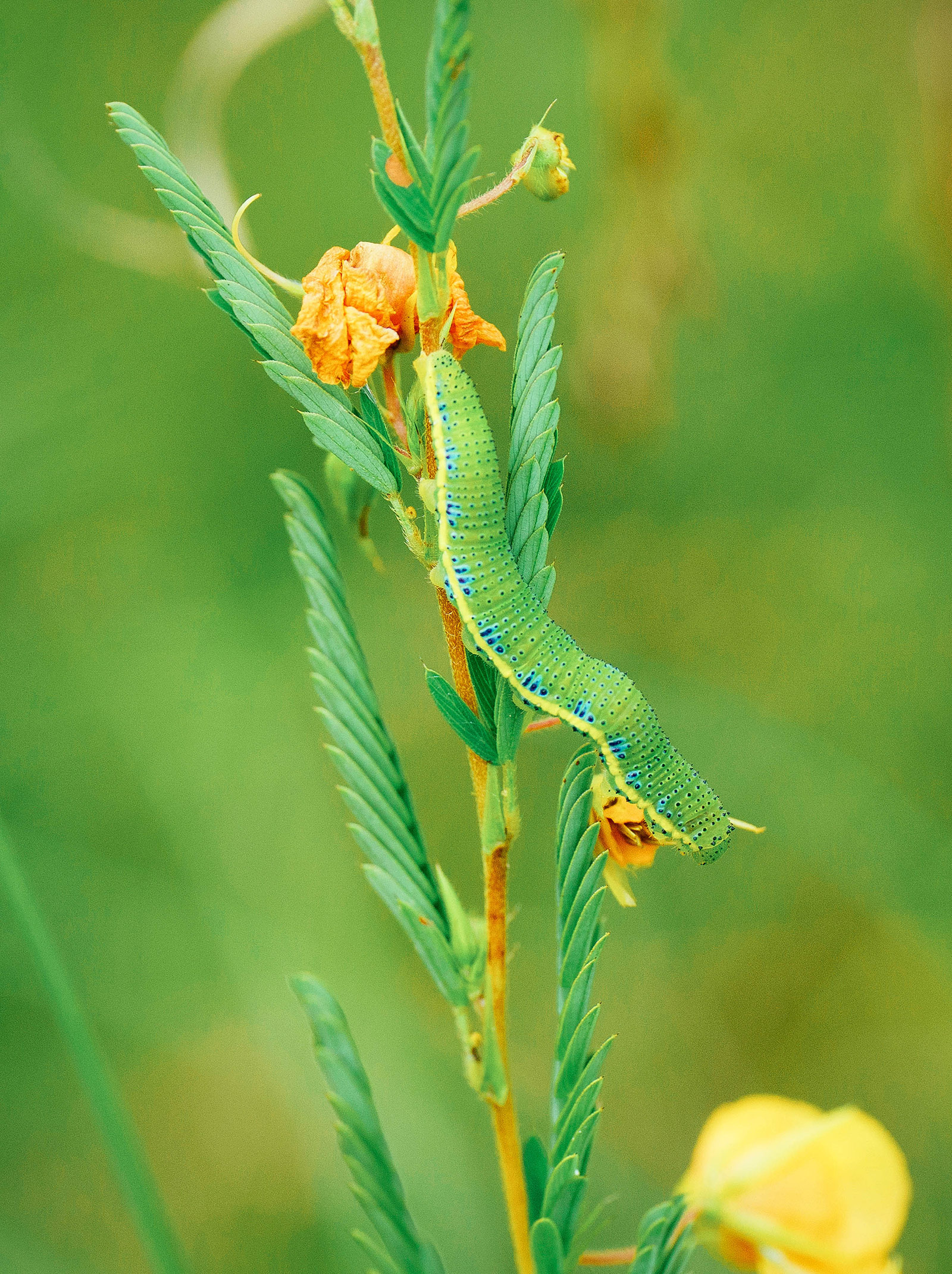
- Scientific name: Phoebis sennae
- Turns into: Cloudless sulphur butterfly
- It can be found in southern Canada (mostly southwestern Ontario), the eastern and southern United States, and all the way down to Argentina.
There are blue or yellow “racing” stripes down the side of the cloudless sulphur caterpillar (also written as cloudless sulfur caterpillar) and black or blue dots all over its body. Its body is green or yellowish-green.
It also has fine hairs that grow along the body, predominantly on the feet and abdomen. This caterpillar can grow to be between 4 to 4. 5 centimeters (1. 6 to 1. 7 to 8 inches long, and this species is different because its color changes based on what it eats.
As an example, cloudless sulphur larvae that only eat green leaves turn a bright green color, while those that only eat yellow flower petals turn a bright yellow color.
Their host plants include sennas, partridge peas, common sensitive plants, clovers, and other legumes.
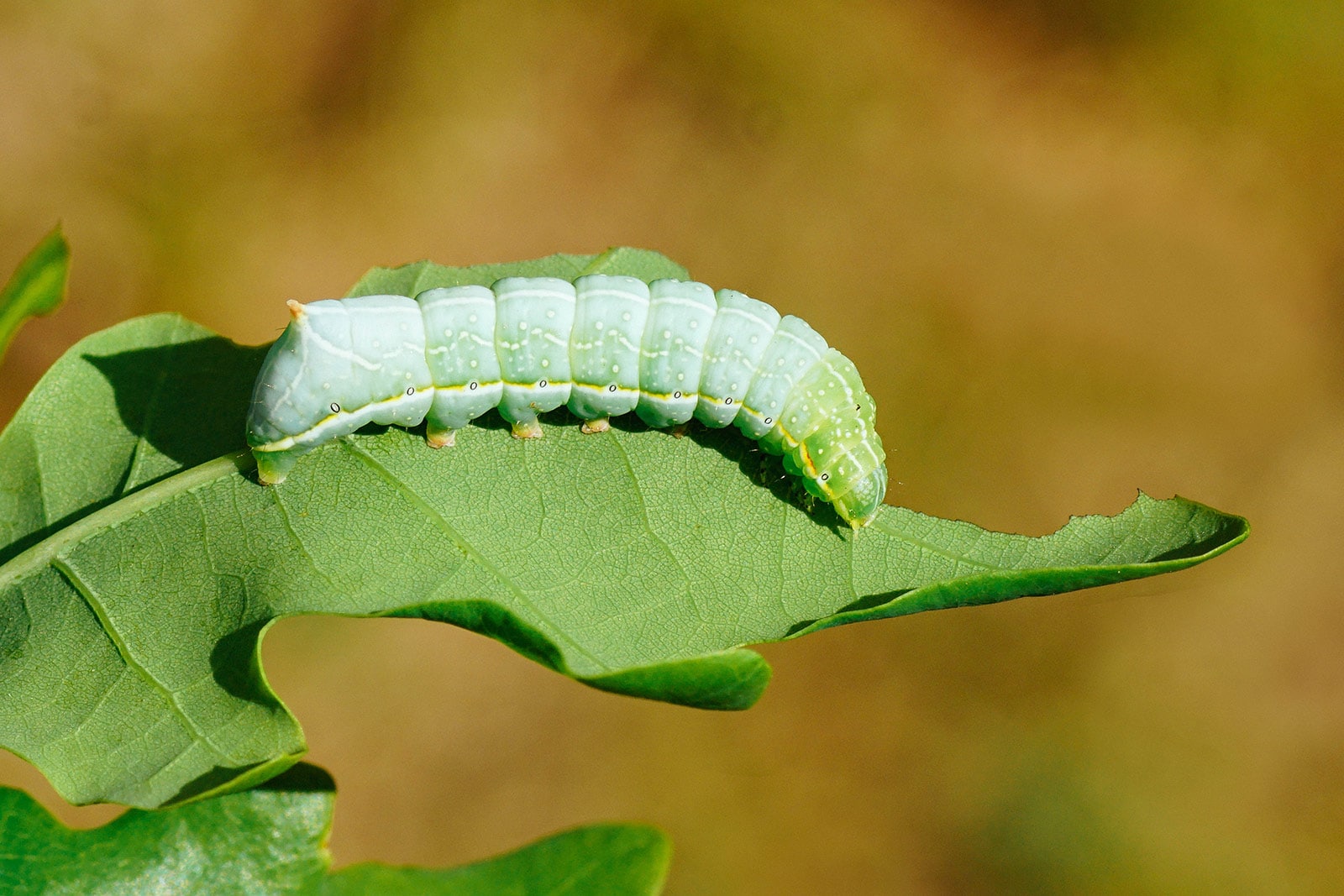
- Scientific name: Amphipyra pyramidea
- Turns into: Copper underwing moth
- Found in: United States and southern Canada
People often mistake the large copper underwing caterpillar for a hornworm, which I talk about further down this list. Its body is a light green color that seems see-through at first. As it grows, it turns a darker green color with yellow stripes running along the sides and a lot of small yellow dots spread out.
This caterpillar can be identified by its large, protruding bump on the back. An adult caterpillar also has a colored tip that looks like a horn at the end.
Copper underwing caterpillars are plump in appearance and will lift the front part of their bodies when resting. Also, they have more legs than most caterpillars—four sets of back legs and three sets of front legs. This a medium-sized caterpillar, averaging less than 4. 5 centimeters (1. 75 inches) in length.
Apple, cherry, maple, oak, walnut, hawthorn, hickory, willow, basswood, blueberry, raspberry, grape, greenbrier, lilac, viburnum, and Virginia creeper are just a few of the woody trees and shrubs that larvae feed on.
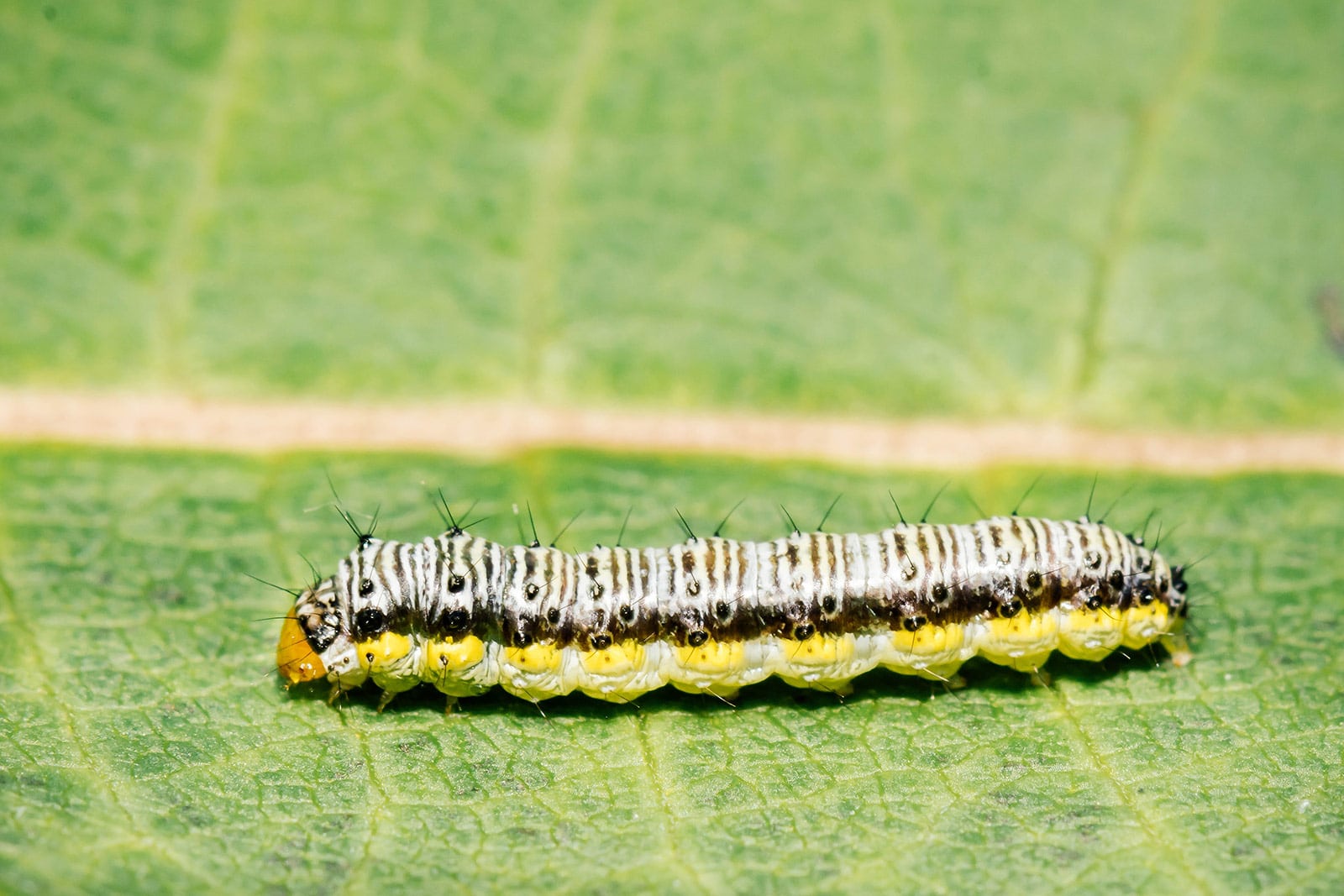
- Scientific name: Evergestis rimosalis
- Turns into: Cross-striped cabbageworm moth
- In the north, it can be found in southern New York, West Virginia, Illinois, Colorado, and Washington. In the south, it can be found from Florida to Texas and Mexico.
Even though it’s called a worm, the cross-striped cabbageworm is one of three main caterpillar pests that attack brassica crops. The other two are the cabbage white caterpillar and the cabbage looper caterpillar.
It can be identified by its small body (about 1 to 1. 5 centimeters, or 0. 4 to 0. 6 inches long) that is light green on the bottom and bluish-green on top. It has a yellow line on each side and many black bands across the back. It also has fine hairs all over its body.
Cross-striped cabbageworms are quite destructive, and just a few larvae can completely skeletonize a plant. They’re a serious problem for brassica crops, including broccoli, kale, cauliflower, collards, and of course, cabbage.
Rough prominent moth caterpillar (green oak caterpillar)
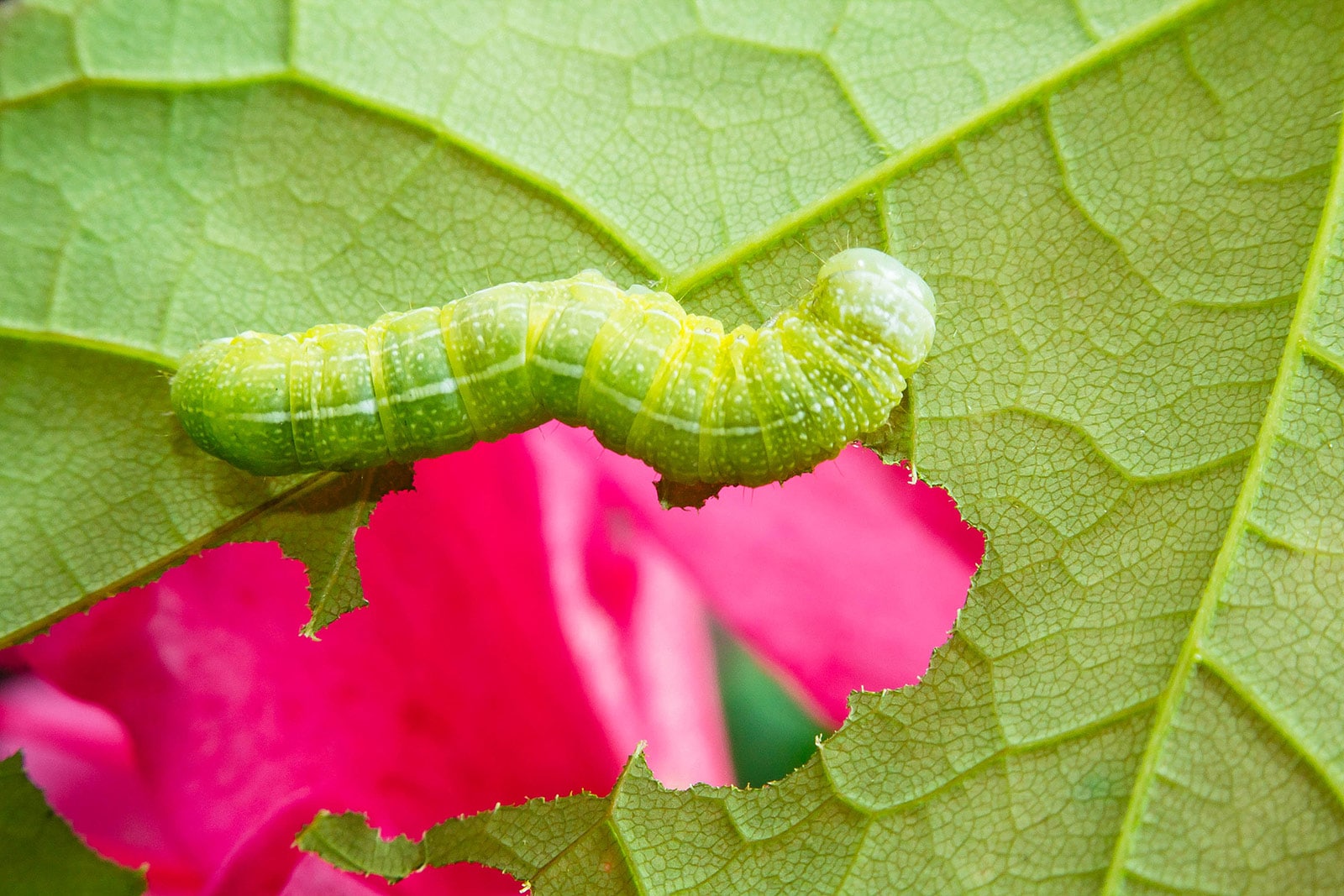
- Scientific name: Nadata gibbosa
- Turns into: Rough prominent moth (white-dotted prominent moth)
- Found in: United States and southern Canada
It is sometimes called the green oak caterpillar. The rough prominent moth caterpillar has a body that is blue-green to bright green with very small white dots all over it. It has a large head capsule, yellow mandibles, and yellow stripes down its body.
This caterpillar is plump and relatively small, growing to be around 1. 7 centimeters (0. 7 inch) long, so it blends in well with its surroundings.
Its main food source is oak leaves, but it also loves to eat the leaves of alder, birch, and maple trees.
Complete guide to green caterpillars that eat holes in your veg garden & the CABBAGE WHITE BUTTERFLY
FAQ
What is a small green caterpillar with a black head?
What are the green caterpillars in my garden?
Are American dagger moth caterpillars poisonous?
What does a green striped caterpillar look like?
Green striped caterpillar with cylindrical body and black head. Black dots on the abdomen produce fine setae. It is a large moth caterpillar with a green body, rear yellow fleshy horn, and two large blue and white eyespots. It can grow up to 8.5cm long.
What is the smallest green caterpillar?
The diamondback caterpillar is one of the smallest green caterpillars you’ll come across as it’s only about 1 centimeter (0.4 inch) long. It has a pale green body, five pairs of prolegs (with the back pair forming a V shape at the rear), and a black or brown head. The body is covered in tiny white spots with black spiny hairs coming out of them.
What does a black caterpillar look like?
The caterpillars are yellow-green with a black line that runs down the dorsal side. Their heads are black and maroon with yellow and red-orange side stripes. The black head has a yellow or orange spot, that can be seen on both sides. These caterpillars feed on vine legumes, including beggars ticks, wisteria, hog peanuts, and blue peas.
What do caterpillars look like?
Young caterpillars are black with white saddles, but mature into a bright green color layered with black stripes down the sides. The stripes can also have yellow dots on top of them which makes this species one of the easiest to identify thanks to its striking features. These colors grow closer together and meet at the head of the caterpillar.
- The Ultimate Guide to Growing Strawberries in Raised Beds - August 8, 2025
- No-Dig Garden Beds: The Easiest Way to Grow a Beautiful Garden - August 6, 2025
- How to Protect and Preserve Wood for Raised Garden Beds - August 6, 2025

